Swiss brand Exped is probably better known for its camping gear than its hiking daypacks, notably its excellent air mats, sleeping bags and backpacking tents. Various Exped products have all performed well in our group tests here at Trail and LFTO over the years, making our top picks in all those categories.
Having said that, the Typhoon 25 waterproof backpack also featured in our recent round-up of the best waterproof packs for 2025, which is partly why we were so keen to try out the brand’s new Skyline 30 pack.
The Skyline range of rucksacks are less specialist packs than the Typhoon, designed as all-rounders for hiking and mountain trekking. Exped describes the Skyline series as "the perfect companion for anyone who likes to be outdoors: lightweight, comfortable, and well-thought-out, down to the last detail".
The range consists of four different models. The smallest are the 12 and 20-litre volumes, ideal for shorter walks and lightweight hikes, while the larger 30 and 45-litre packs are suitable for extended adventures and more demanding mountain terrain.
Of all these, it’s the 30-litre model that seems to be the most versatile, delivering ample load-lugging ability and plenty of practical trail-friendly features in a pack that is compact enough to be a practicable companion for three-season use.
Pros
- Comfortable to carry even with heavy loads
- Rugged and well-built
- Two sizes and adjustable fit
- Great features
- Easy access to main compartment via extended zip
- Includes a raincover
Cons
- Relatively heavy
- Not as well-ventilated as a fully suspended back system
| RRP: | £159.90 / $199.95 |
| Weight: | 1.42kg / 3lb 2.1oz |
| Volume: | 30 litres |
| Sizes: | S/M and L/XL, plus adjustable back system |
Overview
A steel internal frame and high-denier main fabric made from recycled polyester ensure this pack is rugged and robust.
Meanwhile, the back system delivers a great balance of stability and ventilation, thanks to an airy foam-and-mesh back panel and a plush harness.
It’s positively laden with clever features, too. There’s easy access to the main body via an extended zip, ensuring easy rummaging, while clever internal organisation ensures small items won’t end up buried somewhere at the bottom of the pack.
Side pockets are accessible from the top or the side, so you can get to a water bottle without having to stop and take the pack off. A front shove pocket also gives you a convenient place to stuff soggy waterproofs.
There’s useful on-the-go storage, too, with zippered hipbelt pockets and a stretchy shoulder pocket that’ll take a phone or a fistful of trail bars.
It's basically all you could ever ask for, and more besides. Inevitably, this does make the Skyline 30 a chunky monkey.
At around 1.5kg (depending on whether you go for the S/M or the L/XL back lengths), it weighs more than some 50 litre+ backpacking rucksacks. Still, that extra heft is probably not a dealbreaker for a daypack, unless you’re very committed to going fast and light.
Back system
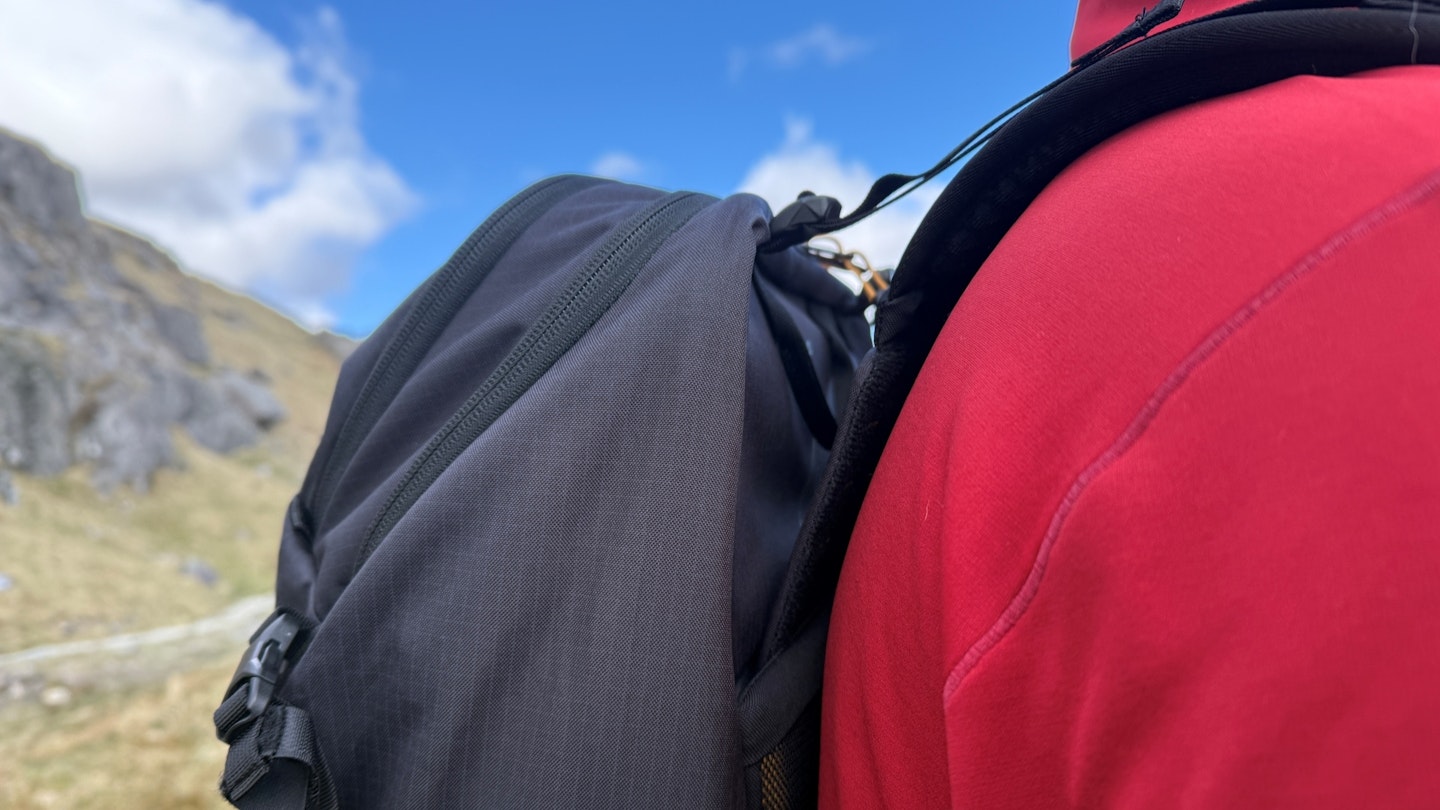
Carrying comfort is usually up there as one of the most important priorities for anyone on the hunt for a new backpack. The Skyline 30 scores highly in this metric.
It’s marketed as a unisex pack but comes in two different torso sizes – either a S/M or a L/XL, designed for back lengths of 43-51cm (17-20ins) and 49-57cm (19-22.5ins) respectively. That wide range of adjustment is made possible by a movable shoulder yoke, which fixes in place with a Velcro panel.
The rest of the back panel employs a technology that Exped calls its Air-Flow system. It’s a contoured foam pad with multiple channels and cut-outs for ventilation, overlaid with a tightly woven mesh that is partly suspended across the top.
The foam mid-sections are also ridged for extra airflow, while the upper and lower thirds, which sit against your shoulders and lower lumbar, have more contact for extra support. It’s very comfortable to wear and seems to strike a good balance between all-round stability and breezy ventilation.
It’s not exactly groundbreaking, being a similar design to other systems like Osprey’s AirScape (as found on the Talon/Tempest packs) and Rab’s Air Contour (as found on the Protium packs). Personally though, we found Exped's version the most comfortable of the three.
Harness and hipbelt
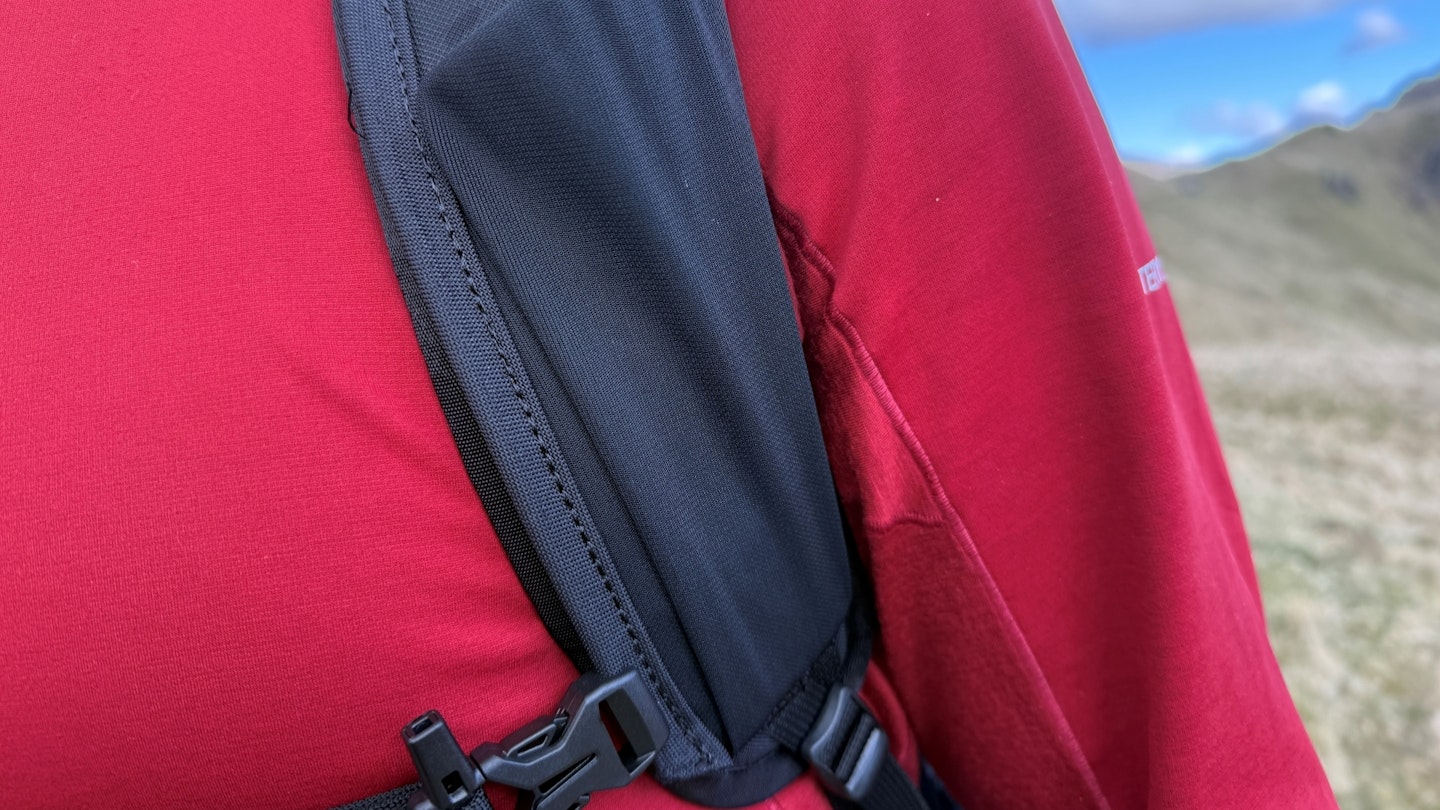
The harness is very well designed. Shoulder straps are tapered in thickness, with chunkier foam padding up top and lighter, thinner foam at the chest. This is great for relieving pressure on shoulders and collarbones.
Perforations in the foam and a fast-wicking open-weave lining fabric add ventilation and breathability. Load lifters and a sliding chest strap (with a safety whistle on the buckle) add stability.
You also get a stretch mesh shoulder pocket and a drinking hose clip on one side as well as an elastic bungee cord on the other, intended for temporarily stashing hiking poles on the move. There are also a couple of webbing loops for attaching other accessories or perhaps a pair of sunglasses.
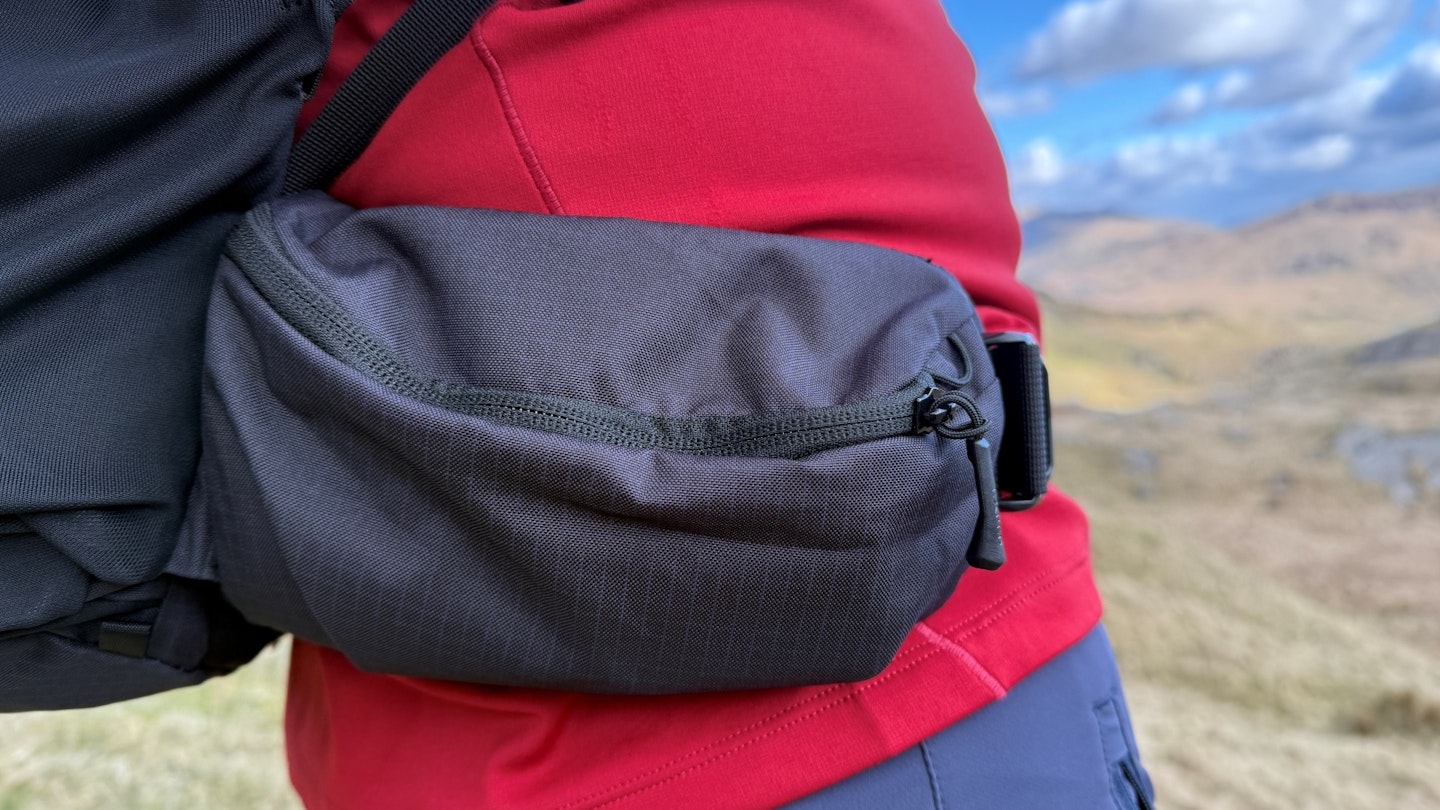
The hip fins are nicely sculpted and padded, again constructed from foam with a breathable fabric overlay.
The foam is slightly stiffer and more structured than that found on many rival packs though, which aids with load transfer but doesn’t feel quite as soft or forgiving as some. The webbing belt is nice and chunky with a solid plastic side-release buckle.
It can be adjusted at either side with a single pull and elastic keepers stop the webbing ‘tails’ from dangling around your waist. The hip fins are wide enough to accommodate two zippered pockets, which are just about big enough to take a modern smartphone.
Design and features
The pack has an internal spring steel perimeter frame for strength and rigidity, which ensures it’s a capable load-lugger. It also gives additional structure so that even if the pack isn’t fully loaded, it maintains its shape without sagging, either when on the ground or on your back.
Main fabrics are extremely tough, being made from 450 x 300 denier polyester, which is PU coated to give a waterproof rating of 1,500mm hydrostatic head.
The seams and zippers are only water-resistant, so the Skyline 30 isn’t fully waterproof (unliked the Exped Typhoon 25), but it offers more weather protection than most daypacks. There’s also a rain cover stashed in the base for extra peace of mind if the heavens open.
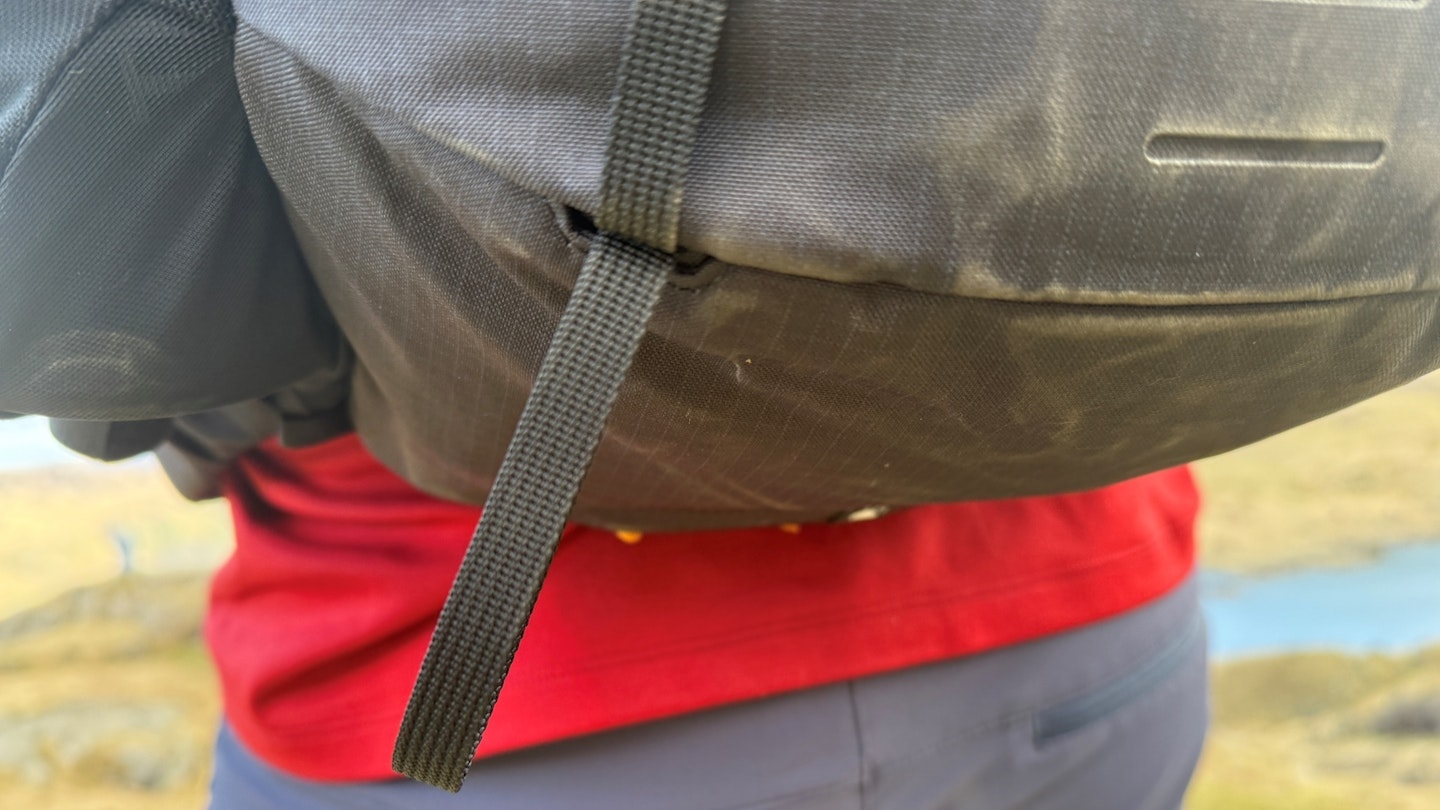
It’s a panel-loading style but the zip extends almost to the base of the pack on one side. Since it’s fitted with two-way zippers, this means you can unzip it from the top but also from the side to give you direct access to the lower part of the main compartment. It’s a very clever design.
The only downside is that one of the side compression straps needs to be unbuckled if you want to fully unzip the entire thing, but that’s a very minor gripe and there’s not really a way around it.
The pack tapers at its base, which means the main compartment is deep but fairly narrow. Luckily, that extended zip makes for easy rummaging. And there’s another bonus: this pack has better internal organisation than any other pack we can recall testing. There are three zippered mesh pockets inside the main body, plus an internal stretch mesh pocket.
If you always find that your smaller bits of kit have ended up right at the bottom of your pack, you’ll love this feature. Same goes for hikers who prefer to keep their water bottle or insulated flask inside their pack, since the mesh sleeve means it won’t get upended or buried amongst all your other gear.
It’s hydration compatible too, but – just like the Rab Protium 27 – the pocket for your water bladder is accessed externally, behind the back panel. This means much less faff when refilling.
Unlike some other external hydration designs, there’s also enough space to prevent a full bladder from pressing against the back panel and causing barrelling. The top opening is tight, though, so depending on which size and type of hydration reservoir you have, sliding it inside might be a struggle.
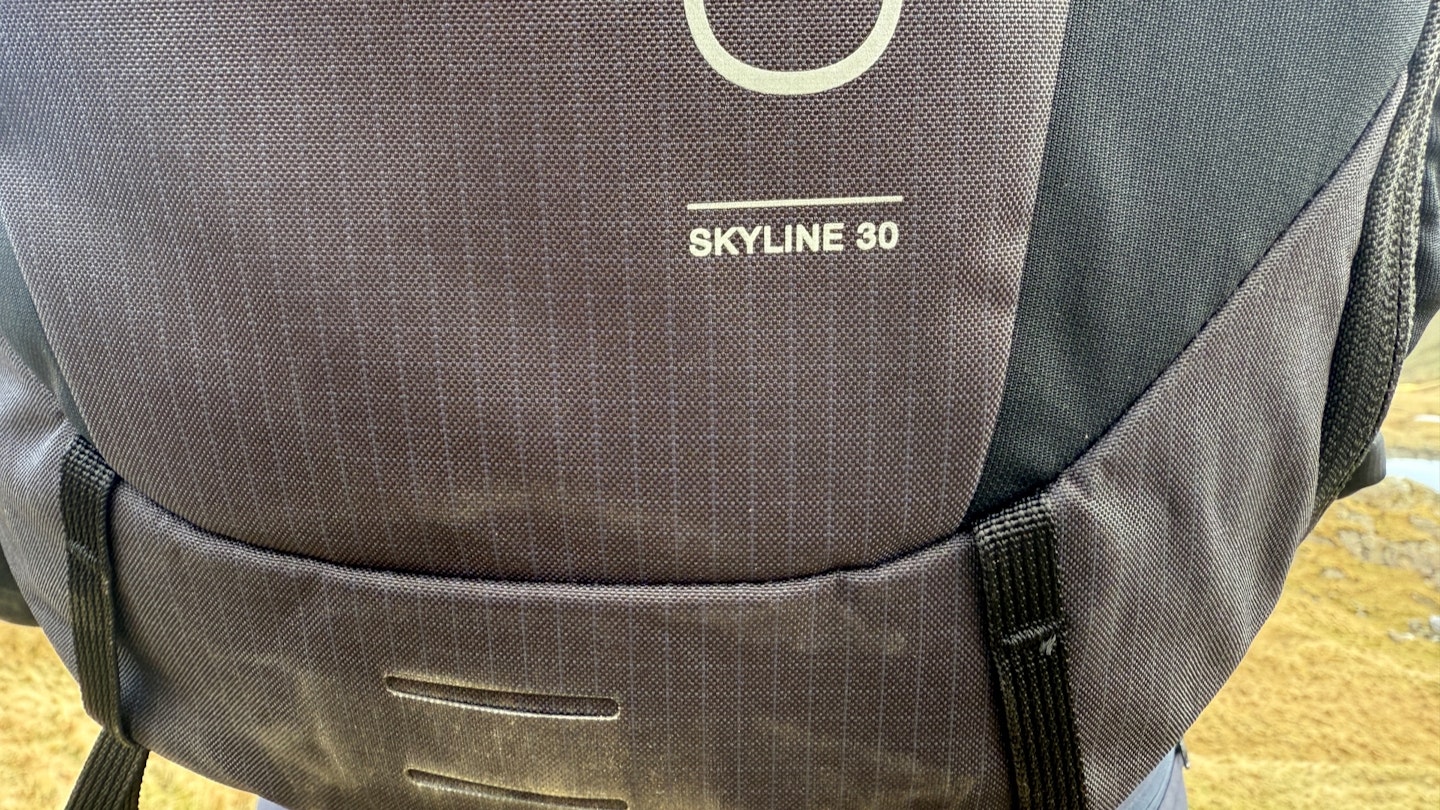
Other external features are also very well thought out. We particularly love the side stretch pockets, which can be accessed from the top or the side, so you can reach around to get your water bottle without taking the pack off (and put it back again afterwards).
The front stretch shove pocket is similarly practical. It’s very roomy and can be over-stuffed if necessary, thanks to a long strip of webbing with a carabiner-style buckle.
This can be attached to the front of the pack in two positions depending on how full the pocket is. The front panel also has laser-cut slots to attach a bike light, as well as dual trekking pole attachment points, with upper bungee drawcords.
A zippered top pocket with an internal key clip rounds out this comprehensive feature set. It really is all you could ask for in a daypack, and arguably more besides.
This inevitably means that the Skyline 30 is not the lightest pack around. In fact, at 1.42kg, it was the heaviest daypack in our 2025 group test. And that’s the S/M size – the L/XL is a hefty 1.55kg.
That’s more than some 50+ litre backpacking rucksacks we’ve tested in the past couple of years. So, for anyone who prefers to go fast and light, that stat alone will probably make the Skyline 30 a non-starter (though it’s worth pointing out that the smaller Skyline 20 is considerably lighter, at 920g).
Sustainability
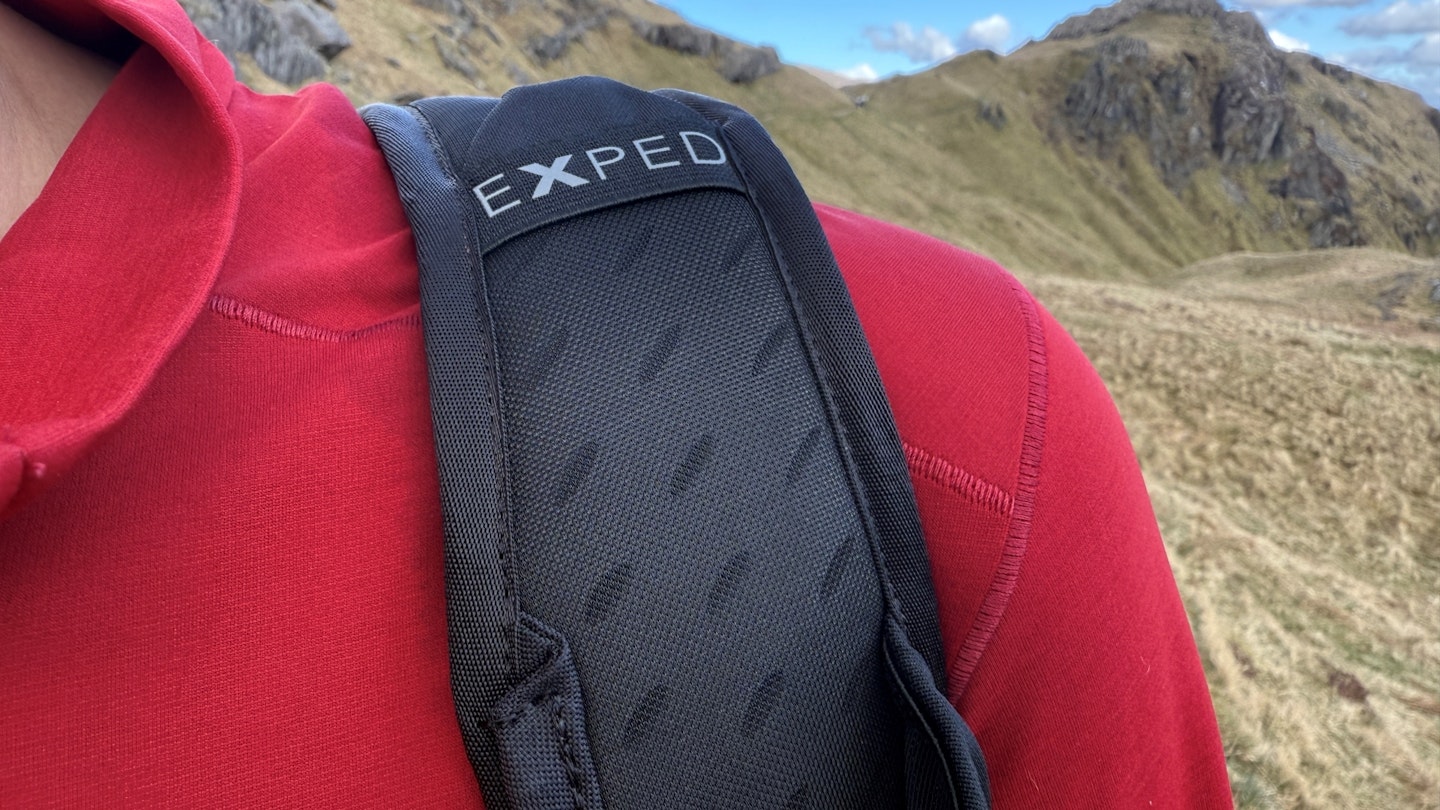
As a brand, Exped has always had a strong focus on sustainability. The Skyline 30 pack uses a high-denier polyester fabric that is 100% recycled and bluesign-approved (one of the strictest manufacturing standards for environmental and consumer protection in textile production).
It's also entirely PFAS-free. This means it has no harmful chemicals from the family of per- and polyfluoroalkyl substances, which are non-degradable, synthetic compounds that have been shown to bioaccumulate in the environment, and which the outdoor industry is in the process of completely phasing out.
Price and competition
With a UK RRP of £155, this is a top-end daypack, although to be fair it does boast 30 litres of carrying capacity, which puts it in the class of ‘large daypacks’.
The excellent build quality, good sustainability credentials and wide range of features also mark it out as a premium pack.
Other options to look at in this category include the handsome and nearly bombproof Fjällräven Kaipak 28 (£150) or the heavy-duty Mystery Ranch Coulee 30 (£180).
There’s also the popular Gregory Zulu 30 (women’s Jade 28) to consider at £165, or alternatively the slightly smaller Osprey Stratos 26 (women’s Sirrus 26), priced at £160.
If you’re on a tighter budget, we’d advise you to look at the Vango Mitra Air 30 (£72.50) or the Sprayway Akka 30 (£75). Decathlon's Quechua 30L MH500 is also absurdly good value at £55.
Verdict
A deluxe daypack in every sense, the Skyline 30 is a premium load-lugger that's rugged, robust and laden with features.
This all adds weight though, which might deter fast and light types. And while the back panel balances stability with ventilation, it’s not as airy as a fully suspended mesh system. But for those who value carrying comfort and efficient organisation on the trail above all else, it’s a great choice.
For more more technical rucksacks, see our list of the best mountaineering backpacks.
Shop this product
About the author

Matt Jones is a freelance journalist based in the heart of Snowdonia National Park, he’s a vastly experienced gear tester and self-confessed outdoor kit geek. Matt’s been one of our main gear testers for the last couple of years and is the first person we call with any complicated kit queries that need in-depth and forensic analysis.



